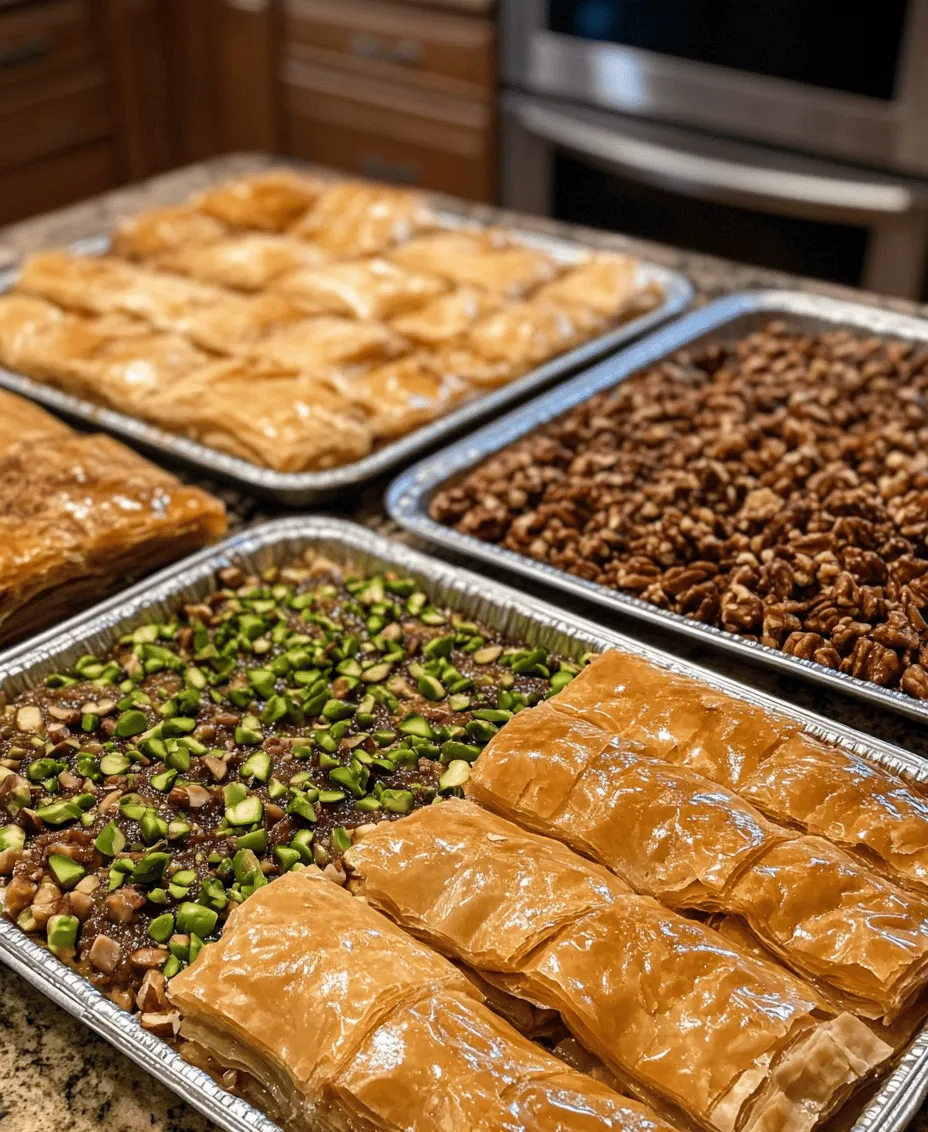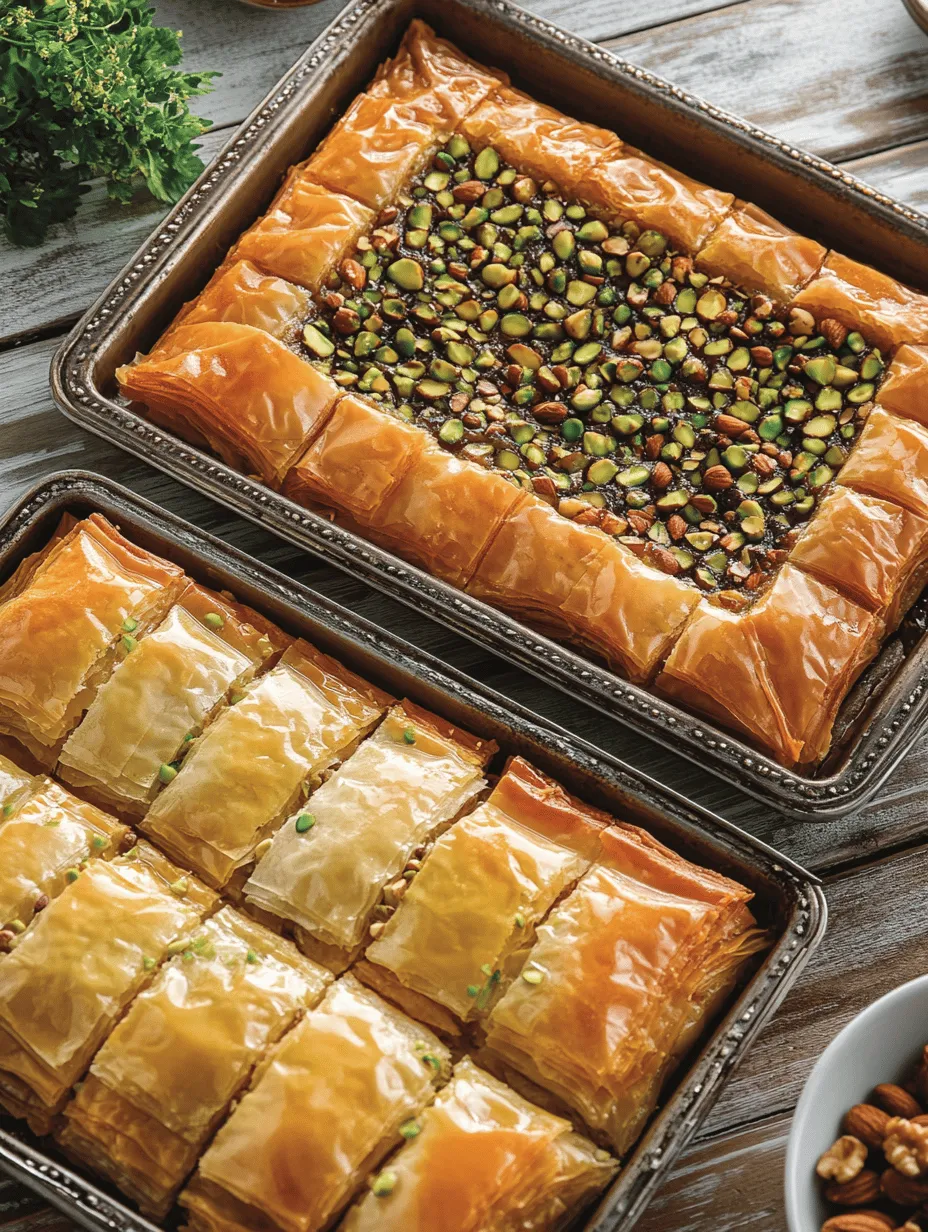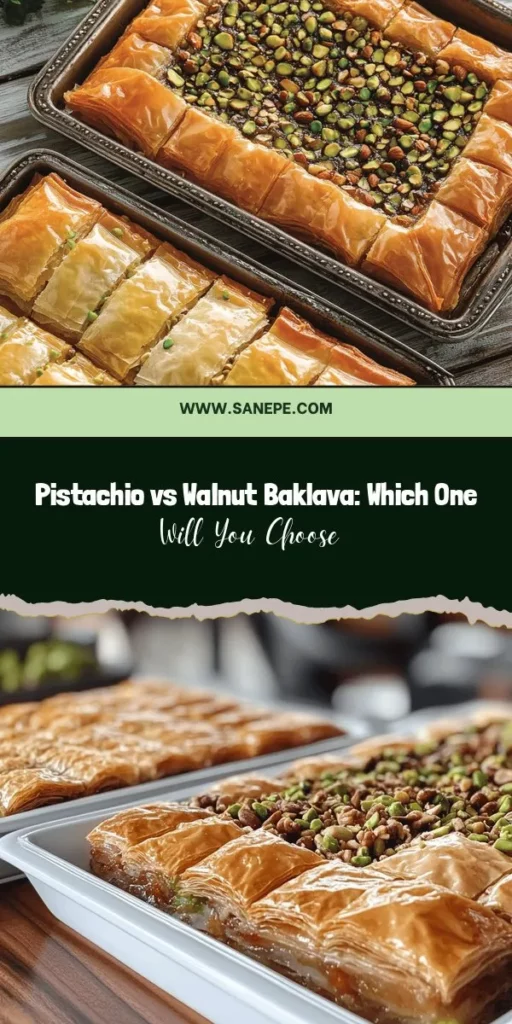Introduction
Baklava is a beloved dessert that transcends borders and has captivated taste buds around the globe with its flaky, buttery layers and rich nut fillings. This iconic sweet treat, often associated with Mediterranean and Middle Eastern cuisines, has become a staple in many cultures, each adding its unique twist to the recipe. The classic debate among baklava enthusiasts often centers around two popular variations: pistachio and walnut.
Pistachio baklava, known for its vibrant green color and distinctive flavor, offers a nutty sweetness that pairs beautifully with the rich syrup that adorns this dessert. On the other hand, walnut baklava, with its earthy, slightly bitter notes, provides a contrasting yet equally delightful experience. In this article, we dive into the intricacies of these two delightful recipes, exploring their unique flavors, textures, and preparation methods.
Whether you’re a seasoned baker or a curious novice, this comprehensive guide will help you master both versions of baklava, allowing you to impress friends and family with your culinary skills.
Understanding Baklava: A Cultural Perspective
Exploring the Origins of Baklava
The origins of baklava are as rich and layered as the dessert itself. While its exact beginnings are somewhat obscure, it is widely believed that baklava has roots in the ancient civilizations of the Middle East, particularly in the regions that are now Turkey and Greece. Some historians trace its lineage back to the Assyrians, who are thought to have layered thin pieces of dough with nuts and honey over 2,000 years ago.
As trade routes opened and cultures intermingled, baklava evolved, taking on various forms and flavors. The Ottoman Empire played a crucial role in popularizing baklava, and it became a symbol of wealth and hospitality. The dessert eventually spread to various parts of Europe and the Mediterranean, each region adding its unique spin on the traditional recipe.
The Significance of Baklava in Mediterranean and Middle Eastern Cuisine
Baklava holds a special place in Mediterranean and Middle Eastern cuisines, often served during celebrations and festive occasions. Its rich, sweet flavor and intricate layers symbolize abundance and prosperity, making it a popular choice for weddings, holidays, and family gatherings. In many cultures, it is customary to serve baklava to guests as a gesture of hospitality, showcasing the host’s culinary prowess.
In addition to its cultural significance, baklava is also a testament to the artistry of pastry-making. The process of creating this dessert involves skillful layering, precise baking, and a keen understanding of flavors, which makes it a cherished tradition passed down through generations.
Cultural Variations and Regional Differences in Baklava Recipes
While the basic components of baklava remain consistent—phyllo dough, nuts, and syrup—each region has developed its distinct variations. For instance, in Turkey, baklava is often made with a generous amount of syrup and features a rich pistachio filling. In Greece, baklava may incorporate cinnamon and cloves into the nut mixture, adding warmth and depth to the flavor.
Furthermore, regional preferences for nuts vary widely. In Lebanon, for example, baklava is commonly made with a combination of walnuts and almonds, while in Iran, saffron may be added to the syrup for an aromatic twist. The variations highlight not only the diversity of ingredients available in different areas but also the cultural significance of baklava as a dessert that brings people together.
Ingredients Breakdown: Pistachio vs. Walnut Baklava
Essential Ingredients for Pistachio Baklava
To create the perfect pistachio baklava, you’ll need a selection of essential ingredients that contribute to its flavor and texture.
1. Phyllo Dough: The foundation of baklava, phyllo dough is a thin pastry that creates the signature flaky layers. It’s crucial to work with fresh, high-quality phyllo to achieve the best texture.
2. Pistachios: The star ingredient of this version, pistachios are not only delicious but also provide a vibrant green hue to the baklava. Their unique flavor profile combines nutty sweetness with a slight creaminess, making them an excellent choice for this dessert.
3. Butter: Melted butter is brushed between the layers of phyllo dough, imparting richness and contributing to that irresistible flakiness. It’s recommended to use unsalted butter for better control over the overall flavor.
4. Sugar: Sugar is essential for the syrup that bathes the baklava after baking. It balances the nutty flavors and adds sweetness to the dish.
5. Water: Combined with sugar, water is simmered to create the syrup, which is poured over the baklava once it is removed from the oven.
6. Lemon Juice: A splash of lemon juice in the syrup adds brightness and helps prevent crystallization, ensuring a smooth and pourable consistency.
Detailed Description of Pistachios and Their Flavor Profile
Pistachios are small green nuts that are harvested from the fruit of the pistachio tree. Their distinctive green color comes from the chlorophyll in the nut, and their flavor is often described as rich, buttery, and slightly sweet. When toasted, pistachios develop an even deeper flavor, making them a perfect choice for baklava.
In addition to their delicious taste, pistachios also offer a variety of health benefits. They are rich in healthy fats, protein, and antioxidants, making them a nutritious addition to any dessert. For the best results, always choose fresh, high-quality pistachios, as stale or rancid nuts can significantly impact the flavor of your baklava.
Importance of Fresh, High-Quality Ingredients
The success of any baklava recipe heavily relies on the quality of the ingredients used. Fresh, high-quality nuts, butter, and phyllo dough are essential for achieving the desired texture and flavor. Investing in premium ingredients not only elevates the taste of your baklava but also enhances the overall experience of this beloved dessert.
Essential Ingredients for Walnut Baklava
The walnut version of baklava offers its own delightful taste profile, and the essential ingredients are similar yet distinct.
1. Phyllo Dough: Just like in the pistachio variation, phyllo dough is a crucial component of walnut baklava. Ensuring the sheets are kept covered while working with them is vital to prevent drying out.
2. Walnuts: The primary ingredient, walnuts, provide a rich, earthy flavor that balances well with the sweetness of the syrup. Their slightly bitter notes contrast beautifully with the syrup’s sugary sweetness.
3. Butter: Melted butter is equally important here, providing richness and aiding in the layering process of the phyllo dough.
4. Sugar: For the walnut baklava, sugar is used in the syrup to enhance sweetness and contrast with the nutty flavor of the walnuts.
5. Water: As with pistachio baklava, water is combined with sugar to create the syrup.
6. Spices: In walnut baklava, spices such as cinnamon or nutmeg can be added to the nut mixture to elevate the flavor profile. These spices add warmth and complexity to the overall taste.
Detailed Description of Walnuts and Their Flavor Profile
Walnuts are a type of tree nut known for their distinctive shape and rich flavor. They have a slightly bitter, earthy taste that intensifies when roasted, making them an excellent choice for baklava. Walnuts are also packed with healthy fats, protein, and antioxidants, contributing to their status as a nutrient-dense food.
When using walnuts in baklava, it’s essential to chop them finely to ensure even distribution throughout the pastry layers. The texture of the chopped walnuts adds a delightful crunch, contrasting with the tender layers of phyllo.
The Role of Spices and Other Ingredients in Enhancing Flavor
Incorporating spices into walnut baklava not only enhances the flavor but also adds depth and warmth to the overall profile. Cinnamon is a classic choice, providing a comforting aroma that pairs beautifully with the earthy notes of the walnuts. Nutmeg or allspice can also be considered for those seeking to experiment with different flavor combinations.
By carefully selecting and balancing the flavors of the nuts and spices, you can create a walnut baklava that is just as enticing as its pistachio counterpart.
Preparation Steps for Both Baklava Recipes
Prepping for Baklava: Tools and Materials Needed
Before diving into the baklava-making process, it’s essential to gather all the necessary tools and materials. A well-organized workspace will make the preparation smoother and more enjoyable. Here’s what you’ll need:
1. Baking Dish: A large, deep baking dish is required to hold the layers of phyllo and nuts. A 9×13-inch dish is commonly used, but you can adjust the size based on your desired serving portions.
2. Pastry Brush: A pastry brush is crucial for generously applying melted butter between the layers of phyllo dough.
3. Food Processor: A food processor makes quick work of chopping nuts and combining them with spices, ensuring a fine texture.
4. Sharp Knife: A sharp knife is necessary for cutting the baklava into pieces before baking. This step is important to ensure even cooking and easy serving.
5. Saucepan: A medium saucepan is needed to prepare the syrup. It should be large enough to hold the sugar and water while allowing for easy stirring.
6. Measuring Cups and Spoons: Accurate measurement of ingredients is key to achieving the perfect baklava, so have these tools on hand.
Importance of Workspace Organization
Having a clean and organized kitchen is vital when preparing baklava. Ensure all ingredients are pre-measured and ready to go before you start layering the phyllo dough. This preparation will help prevent mistakes and make the process more enjoyable, allowing you to focus on perfecting your baklava.
Layering the Phyllo Dough: Techniques for Success
Layering phyllo dough is a fundamental step in creating baklava, and there are a few techniques to ensure success:
1. Thawing Phyllo: If using frozen phyllo dough, be sure to thaw it in the refrigerator overnight. This prevents it from becoming dry and brittle.
2. Covering Phyllo: As you work with phyllo dough, keep the sheets covered with a damp towel to prevent them from drying out. This is crucial, as dried phyllo can become difficult to handle and may tear easily.
3. Brushing with Butter: Use a pastry brush to generously apply melted butter to each layer of phyllo dough. Aim for at least 8-10 layers for a solid foundation, brushing butter between each layer.
4. Even Distribution: When layering, ensure that the sheets are aligned evenly in the baking dish. This will help the baklava maintain its shape during baking and provide a consistent texture.
Step-by-Step Instructions for Creating the Perfect Base
1. Prepare Your Ingredients: Gather all your ingredients and tools. Preheat your oven to 350°F (175°C).
2. Prepare the Phyllo Dough: Unroll the phyllo dough and lay it flat on a clean surface. Keep the unused sheets covered with a damp towel.
3. Brush the Baking Dish: Use the pastry brush to apply a thin layer of melted butter to the bottom of your baking dish.
4. Layer the Phyllo: Begin layering the phyllo sheets in the baking dish, brushing each with melted butter as you go. Aim for 8-10 layers, ensuring even coverage.
5. Add the Nut Mixture: Once you have a solid base of phyllo, spread the nut mixture (whether pistachio or walnut) evenly over the layered dough.
6. Continue Layering: Repeat the process of layering phyllo and brushing with butter, alternating with layers of nuts until you reach the desired height, finishing with a top layer of phyllo.
7. Cut the Baklava: Before baking, use a sharp knife to cut the baklava into diamond or square shapes. This step is essential for even cooking and easy serving.
Creating the Nut Mixtures: Flavorful Combinations
Creating the nut mixtures for both pistachio and walnut baklava is a straightforward yet enjoyable process. Here’s how to combine the nuts and spices for each version:
1. For Pistachio Baklava:
– Place the shelled pistachios in a food processor and pulse until finely chopped but not powdered. Aim for a coarse texture that still has some crunch.
– In a bowl, combine the chopped pistachios with a touch of sugar or cinnamon, if desired. This mixture will be layered between the phyllo sheets.
2. For Walnut Baklava:
– Similarly, place the walnuts in a food processor and pulse until finely chopped. Be cautious not to over-process, as you want to maintain some texture.
– Combine the chopped walnuts with spices like cinnamon or nutmeg in a bowl. This adds warmth and depth to the nut mixture.
The Significance of Texture in the Nut Mixture
Achieving the right texture in the nut mixture is crucial for both types of baklava. The nuts should be finely chopped to ensure they distribute evenly throughout the layers, but they should retain enough texture to provide a delightful crunch. This balance is key to creating a baklava that is both visually appealing and delicious to eat.
As you embark on this baklava showdown of pistachio vs. walnut, the careful selection of ingredients and attention to detail in preparation will set the stage for a delectable dessert experience. Each layer, each nut, and each technique used contributes to the final masterpiece, inviting you to explore the rich flavors and cultural significance of this treasured dish.

Layering Techniques for Even Distribution
To achieve the perfect baklava, the layering of phyllo dough and nuts is crucial. Start by ensuring that your phyllo sheets are kept covered with a damp cloth while you work to prevent them from drying out. Here are some effective layering techniques to consider:
1. Even Layering: When layering phyllo sheets, use about 8 to 10 sheets per layer, brushing each sheet with melted butter before adding the next. This not only helps in achieving a crisp texture but also ensures that they do not stick together during baking.
2. Nut Distribution: For the filling, whether you choose pistachios or walnuts, spread the nut mixture evenly over the phyllo layers. Use a spatula to flatten it out gently, creating a uniform surface. This ensures that every bite of baklava has a balanced flavor.
3. Alternate Layers: If you’re experimenting with both pistachio and walnut baklava, consider alternating layers of the two nut mixtures. This method offers a delightful surprise in each piece and allows for a unique tasting experience.
Tips for Cutting and Shaping Before Baking
Before baking your baklava, proper cutting and shaping are essential to ensure easy serving and optimal baking results. Here are some tips to guide you through this process:
1. Cutting Shapes: Use a sharp knife to cut the baklava into diamond or square shapes before it goes into the oven. Make sure to cut through the layers down to the bottom of the pan, as this will help the syrup penetrate each piece later.
2. Scoring Technique: Score the top layer lightly with a knife. This not only helps in creating the desired shapes but also prevents the phyllo from puffing up too much during baking, which can lead to uneven pieces.
3. Spacing Between Cuts: Leave a bit of space between each cut to allow for expansion as the baklava bakes. This will help maintain the shape and ensure even cooking.
Baking Your Baklava to Perfection
Oven Settings and Baking Tips
Baking baklava to perfection requires careful attention to oven settings and timing. Here are some essential tips:
1. Preheat the Oven: Always preheat your oven to 350°F (175°C) before placing the baklava inside. A properly preheated oven ensures that the baklava cooks evenly and promotes the desired golden-brown finish.
2. Baking Time: Bake the baklava for approximately 45 to 55 minutes, or until it achieves a golden hue. Keep an eye on it during the last 10 minutes to prevent over-browning.
3. Rotating the Pan: If your oven has hot spots, consider rotating the pan halfway through the baking process to ensure even cooking.
The Science Behind Achieving That Golden Brown Finish
Achieving that perfect golden brown color is not just about cooking time; it’s also about the interaction between butter and phyllo dough.
1. Butter’s Role: The melted butter not only adds flavor but also helps crisp up the layers of phyllo. As the butter seeps into the dough, it creates steam that helps separate the layers, resulting in a flaky texture.
2. Phyllo Dough Behavior: During baking, the moisture from the butter evaporates, allowing the layers to puff up slightly. This puffing action is crucial in achieving the light and flaky consistency that baklava is known for.
Troubleshooting Common Baking Issues
Even the best bakers can encounter issues when making baklava. Here are some common problems and solutions:
– Baklava is Soggy: If your baklava turns out soggy, it may be due to too much syrup being added or not allowing it to rest properly before serving. Ensure that you pour the syrup over cooled baklava and allow it to rest for several hours to absorb the syrup evenly.
– Uneven Browning: If parts of your baklava are browning faster than others, consider adjusting the oven rack position or using an oven thermometer to ensure accurate temperature.
Making the Sweet Syrup: The Finishing Touch
No baklava is complete without its signature syrup, which enhances its flavor and texture.
The Role of Syrup in Baklava
The syrup is a critical component that adds sweetness and moisture to the baklava. Here’s how to make it:
– Ingredients: The basic syrup consists of sugar, water, lemon juice, and optional flavorings like honey or rose water. Each ingredient plays a role:
– Sugar: Provides sweetness and thickens the syrup.
– Water: Acts as a base for the syrup.
– Lemon Juice: Enhances flavor and helps prevent crystallization.
– Flavorings: Optional ingredients like honey or cinnamon add depth.
Step-by-Step Guide to Preparing the Syrup
1. Combine Ingredients: In a saucepan, combine 1 cup of sugar, 1 cup of water, and 1 tablespoon of lemon juice.
2. Heat and Stir: Bring the mixture to a boil over medium heat, stirring until the sugar dissolves.
3. Simmer: Reduce the heat and let it simmer for about 10 minutes. If using additional flavorings, add them during this stage.
4. Cool: Remove from heat and let the syrup cool completely before pouring it over the baklava.
Pouring Syrup Over Baklava: Techniques for Even Distribution
1. Timing: Pour the syrup over the baklava immediately after it comes out of the oven. The contrast between the hot baklava and the cool syrup helps in better absorption.
2. Method: Use a ladle to drizzle the syrup evenly over the cut pieces, ensuring all layers receive a coating. This method prevents any sogginess in certain areas and ensures a balanced sweetness.
3. Resting Time: Allow the baklava to rest for at least 4 hours or ideally overnight. This resting period is crucial for the syrup to penetrate the layers fully, enhancing the overall flavor.
Serving and Enjoying Baklava
Presentation Ideas for Serving Baklava
– Plating: Serve baklava on a beautiful platter, garnishing with crushed nuts or a dusting of powdered sugar for an elegant touch.
– Individual Portions: For a more refined presentation, consider serving individual pieces in small cupcake liners or on dessert plates.
Creative Serving Suggestions
1. Toppings: Consider drizzling melted chocolate or a sprinkle of cinnamon to enhance the flavor profile.
2. Pairings: Baklava pairs beautifully with a range of beverages. Traditional pairings include Turkish coffee or mint tea, but it also complements sweet wines and herbal infusions.
Comparing Flavors: Pistachio vs. Walnut
When it comes to baklava, the choice between pistachios and walnuts can make a significant difference in flavor and texture.
Tasting Notes for Both Variations
– Pistachio Baklava: Offers a vibrant green hue and a rich, nutty flavor with a slightly sweet and buttery finish. The unique flavor of pistachios adds an exciting twist that stands out.
– Walnut Baklava: Provides a deeper, earthier flavor with a satisfying crunch. The natural oils in walnuts lend a rich, buttery taste, complementing the sweetness of the syrup beautifully.
Preferences and Popular Trends Among Baklava Lovers
While both variations of baklava are beloved, trends often lean toward pistachios for their vibrant color and unique flavor. However, walnut baklava remains a classic choice, particularly among those who appreciate its traditional roots.
Conclusion
In the battle between pistachio and walnut baklava, both versions offer distinct flavor profiles and textures that cater to different palates. By mastering the techniques and understanding the ingredients that make each variation unique, you can create a deliciously satisfying dessert that celebrates the rich tradition of baklava. Whether you prefer the vibrant nuttiness of pistachios or the earthy depth of walnuts, both recipes promise to deliver a delightful culinary experience that will keep your guests returning for more. Embrace the art of baklava-making, and savor the sweet rewards of your efforts as you indulge in this timeless dessert.


